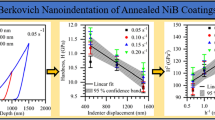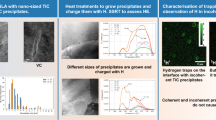Conclusions
The experimental results show that, starting from 800°C, friction of the boron carbide is characterized by high ductility associated with the formation of planar defects. The results show that the depth of the deformed layer to temperatures of 800–1000°C is determined by the grain size and in the regions of the coarse-grained material the layer is 10–15 μm deep which is 3–5 times greater than in the areas of the fine-grained material. The products of wear do not form a continuous layer on the friction surface of the Bi4C-B4C pair and are distributed in the form of individual clusters. Friction of this pair in air at temperatures above 600°C is accompanied by the formation of quasiamorphous oxide films.
Similar content being viewed by others
Literature cited
Yu. G. Tkachenko, “Friction and wear of oxygen-free refractory compounds and materials based on these compounds at high temperatures, a review,” Trenie Iznos,2, No. 5, 864–876 (1981).
A. N. Pilyankevich, V. F. Britun, Yu. G. Tkachenko, and V. K. Yulyugin, “Electron-microscopic examination of the surface layers of titanium carbide after friction at 20–1200°C,” Poroshk. Metall., No. 1, 63–67 (1983).
A. N. Pilyankevich, V. F. Britun, Yu. G. Tkachenko, and V. K. Yulyugin, “Changes in the structure of the surface layers of aluminum nitride in friction,” Poroshk. Metall., No. 6, 76–81 (1984).
V. V. Sychev, Yu. G. Tkachenko, and M. S. Koval'chenko, “Equipment for examining high-temperature processes of friction and wear in vacuum and gas media,” Fiz.-Khim. Mekh. Mater., No. 5, 77–78 (1971).
Yu. G. Tkachenko and I. N. Gorbatov, “Equipment and method of examining friction and wear at high temperatures in air,” Zavod. Lab., No. 6, 750–752 (1977).
A. N. Pilyankevich and V. F. Britun, “Preparation of specimens of refractory compounds for transmission electron-microscopic examination,” Poroshk. Metall., No. 11, 97–100 (1981).
Ya. D. Vishnyakov, Modern Methods of Examining the Structure of Deformed Crystals [in Russian], Metallurgiya, Moscow (1975).
K. H. G. Ashbee, “Defects in boron carbide before and after neutron irradiation,” Acta Metall.,19, No. 10, 1079–1085 (1971).
Author information
Authors and Affiliations
Additional information
Translated from Poroshkovaya Metallurgiya, No. 8(284), pp. 93–97, August, 1986.
Rights and permissions
About this article
Cite this article
Pilyankevich, A.N., Britun, V.F., Tkachenko, Y.G. et al. Structure of surface layers of boron carbide after friction in the temperature range 20–1400°C. Powder Metall Met Ceram 25, 690–694 (1986). https://doi.org/10.1007/BF00796744
Received:
Issue Date:
DOI: https://doi.org/10.1007/BF00796744




